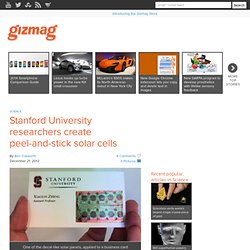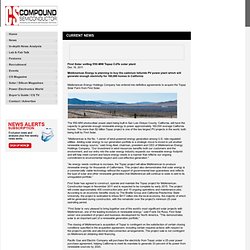

Solar Roadways passes $1.4 million in crowdfunding: Just short of the $56 trillion required, but not bad for a crazy idea. Over the weekend, the Solar Roadways project on Indiegogo reached its target of $1 million.

At the time of publishing, that figure is now north of $1.4 million, with five days left to go. The concept is verging on utopian: By replacing the USA’s concrete and asphalt roads with solar panels, we could produce three times more electricity than we consume, instantly solving just about every energy problem we have (geopolitical stuff, reliance on fossil fuels, CO2 production, etc.) It’s not hard to see why Solar Roadways has attracted so much attention and money: On paper, it really does sound like one of the greatest inventions ever. In reality, though, where, you know, real-world factors come into play, it will probably never make the jump from drawing board to large-scale deployment. New method speeds search for solar energy storage catalysts.
Looking through a UV-blocking filter, the green spots show the location of active catalysts on the electrode underneath the fluorescent mesh (Photo: James B.

Gerken) Image Gallery (2 images) Storing solar energy for the periods of time when the sun isn’t shining is key to improving solar technology. The energy produced can be stored in batteries or used to produce fuel that can act as storage. Stanford University researchers create peel-and-stick solar cells. Traditionally, thin-film solar cells are made with rigid glass substrates, limiting their potential applications.

Flexible versions do exist, although they require special production techniques and/or materials. Now, however, scientists from Stanford University have created thin, flexible solar cells that are made from standard materials – and they can applied to just about any surface, like a sticker. To make the peel-and-stick cells, the researchers started by applying a 300-nanometer layer of nickel onto a rigid silicon/silicon dioxide wafer.
Nikola Tesla - The Untold Story. Nanotube electrodes improve solar cells. Photocurrent electrons overpower solar photons. Dec 16, 2011 Researchers from NREL have developed a solar cell using PbSe quantum dots which exhibits multiple exciton generation The U.S.

First Solar selling 550-MW Topaz CdTe solar plant. Dec 16, 2011 MidAmerican Energy is planning to buy the cadmium telluride PV power plant which will generate enough electricity for 160,000 homes in California MidAmerican Energy Holdings Company has entered into definitive agreements to acquire the Topaz Solar Farm from First Solar.

The 550-MW photovoltaic power plant being built in San Luis Obispo County, California, will have the capacity to generate enough renewable energy to power approximately 160,000 average California homes. The more than $2 billion Topaz project is one of the two largest PV projects in the world, both being built by First Solar.
“MidAmerican is the No. 1 owner of wind-powered energy generation among U.S. rate-regulated utilities. Adding solar energy to our generation portfolio is a strategic move to invest in yet another renewable energy source,” said Greg Abel, chairman, president and CEO of MidAmerican Energy Holdings Company. Compound Semiconductor.
America must not back down on sustainable energy. Clockwise from top left: Sens.

John Kerry, Sheldon Whitehouse, Barbara Boxer, and Bernie Sanders.If you read just the headlines these days, you might think renewable energy in America is going the way of Solyndra. Don’t take our word for it: A recent headline from Fox News declared “ENTIRE Solar Industry on Brink of Collapse.” We cannot allow long-time opponents of renewable energy to focus the discussion only on Solyndra (whose higher-priced panels could not compete as solar costs came down) when we should be thinking about competing with China to win the next energy revolution.
Why? Because the race is on to put the right policies in place so hundreds of thousands of new, well-paying renewable energy jobs will be created here, and not in China. The truth is we can win this race. Semprius Bets on Super-Small Solar Cells. Solar power plant. One Trillion Dollars Invested in Clean Energy In Past 7 Years. Written by Matthew McDermott Bloomberg New Energy Finance has announced that the clean energy sector has passed a very notable benchmark.

Since records began being kept in 2004, one trillion dollars have been invested. Why 2004? HyperSolar Fuel Technology to Mitigate Dangerous CO2 Emissions. Evergreen Solar Finds Chinese Buyer for Its Technology. Report Details Europe's Offshore Wind Ambition. Smart Grid Will Raise Ceiling for Use of Renewables. Google's Search for More Efficient and Low-cost Solar Thermal Power Plant Designs.
Solar in the Asia Pacific Region Booms: China's 2011 Installs May Surpass America's for the First Time. Champions of Photovoltaics Technology. $1 Billion Solar Project Goes Ahead Without DOE Backing. Part 2: How Tariffs Could Impact Solar Industry. The Prettiest Solar Car in the World Comes From Bochum. Solar cars aren’t traditionally thought of as being pretty.

The University of Bochum, however, put some thought into the aesthetics of the car they brought to Australia’s World Solar Challenge this year and it paid off – they didn’t finish the race, but they did get a prize anyway. The prize given to the University of Bochum was not for participation – it was the third time in a row the university has won the Design Award, which is presented to vehicles which innovatively and spectacularly embody the theme of electric mobility within the confines of the rules of the World Solar Challenge. Overall, the team only placed 26th – it was one of the vast majority of solar cars that didn’t finish the race under its own power.
Only 7 cars, in fact, drove the entire distance down to Adelaide; the rest were packed up into their support convoys and straggled in, victims of bush fires, rain, and generally bad weather. Source | Image: Oekonews.at. UK Faces Growing Opposition to Solar Tariff Cuts. Guest Blogs - Photovoltaics Evolve Amid Cost Challenges. Light created from vacuum. Apple Patents Next Generation Solar Technology. The US Patent and Trademark Office just revealed that Apple has been granted 20 new patents which focus on next generation solar technology.

According to PatentlyApple, the patents not only cover solar technology being used to extend the battery lives of personal devices, but will also see the development of a cool new product – a specialized back panel reflector that uses sunlight to illuminate laptop screens. According to design drawings from Apple, the back panel reflector uses a mirror pointed at the sun to direct solar rays towards a screen to supplement LED backlights with natural light.
The patents also specify designs for future Macbooks topped with photovoltaic panels and plans for new solar cell assembly methods and apparatuses for assembling integrated circuit components to substrates. These solar arrays can be used on small personal devices, enabling Apple devotees to use solar energy to recharge their future iPhones and iPads. . + US Patent Office Via PatentlyApple. INTERVIEW: University of Maryland Wins Big at the 2011 Solar Decathlon. Here at Inhabitat we’re suckers for the Solar Decathlon — the biennial design/build competition in which university design teams from all around the globe battle it out on the National Mall in Washington DC to see who can design and build the best solar-powered home.

This year’s Solar Decathlon was a nail-biter of a competition, but it was the University of Maryland team which ultimately triumphed over all the other teams with an elegant, water-conservation focused home called WaterShed. We were fascinated by this beautiful winning home, and sat down with project design lead and student designer David Gavin to find out more about how the house came together. China shelves U.S. solar project in trade row. California Approves High-Priced Mojave Solar Project Over Objections. California regulators on Thursday approved a 25-year contract for a 250-megawatt solar thermal plant over objections from their staff that it would cost utility customers twice as much as other renewable energy projects. The 4-1 decision by the California Public Utilities Commission to green-light the power purchase agreement, or PPA, with Pacific Gas & Electric underscores the politics driving some renewable energy projects.
It also raises questions about the economic viability of an older solar trough technology that the developer, Abengoa Solar, will deploy for the Mojave Solar Project in the Southern California desert. “The PPA unnecessarily saddles ratepayers with extraordinary above-market costs – $1.25 billion,” said Commissioner Mike Florio, who voted against the contract at Thursday’s meeting. Graphene shows unusual thermoelectric response to light. Astronergy’s Thin Film Photovoltaic Panels to be Used in Thailand Solar Park. By Cameron Chai Thailand Solar Park Astronergy’s thin film photovoltaic panels have experienced a raise in demand as they are competitively priced, use low voltage and have a superior efficiency of up to 10%.
Dr. Liyou Yang, who serves as the Chief Executive Officer at Astronergy, stated that the production of thin film cells needs minimal energy and they can be produced using various methods. Google invests US$168 million in world’s largest solar power tower plant. Model rendering of ISEGS, the world's largest solar power tower being built in California Image Gallery (2 images) Solar debate simmers as feds deliver $90 million loan for southern Colorado project. Critics of large, utility-scale solar power plants like the one that recently landed a U.S. Department of Energy (DOE) loan guarantee in southern Colorado say the feds need to better vet energy technology before putting so many taxpayer dollars on the line. “There’s tremendous speculative energy driving new solar technologies,” Ceal Smith of the Alamosa-based Renewable Communities Alliance told the Colorado Independent in reaction to a $90 million loan guarantee for the 30-megawatt Alamosa Solar Generating Project.
“DOE does need to do a better job of assessing renewable energy technologies and business models rather than succumbing to the Wall Street bubble machine that often drives fancy, expensive behemoths — like Stirling dish, parabolic trough and power tower technologies — that have little to no chance of competing on its own,” Smith added. “If a technology is big with a lot of moving parts, be suspicious.” Smith, however, is a proponent of more distributed, roof-top solar projects. Ascent Solar + Samsonite = Solar Luggage. Ascent Solar Technologies, Inc. (NASDAQ:ASTI) yesterday announced its flexible solar panels will soon be featured on a new line of product from Samsonite, one of the world’s biggest makers of luggage. Here’s a press release blurb from Samsonite’s VP of Sales and Marketing, Lynne Berard: “As our lives depend more and more on mobile electronics and the need to power and carry such devices, we believe that integrating solar panels into our carrying case solutions will be a game changer in the industry.
By utilizing the unique, flexible, lightweight, rugged and subtle modules from Ascent Solar, we are able to provide our customers with power on the go, while not compromising our stringent standards for quality and style.” Himalayas: Best place to harness solar power. Bangalore: Researchers in Japan claim the Himalayas have a large potential of photovoltaic (PV) electric power generation from sunlight that can supply energy to India and China.
They suggest these mountains could be more ideal than hot deserts for locating solar power generators. The research by Kotaro Kawajiri and colleagues at the National Institute of Advanced Industrial Science and Technology in Tsukuba, Japan, appears in the latest issue of American Chemical Society (ACS) journal Environmental Science & Technology. Installed cost of solar photovoltaic systems in U.S. declined significantly in 2010 and 2011.